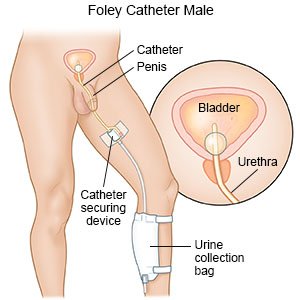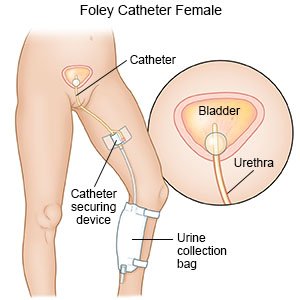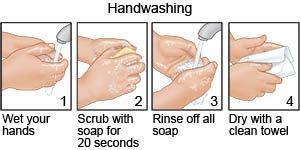Foley Catheter Placement and Care
Medically reviewed by Drugs.com. Last updated on Apr 6, 2025.
A Foley catheter is a sterile tube that is inserted into your bladder to drain urine. It is also called an indwelling urinary catheter.
 |
 |
DISCHARGE INSTRUCTIONS:
Return to the emergency department if:
- Your catheter comes out.
- You suddenly have material that looks like sand in the tubing or drainage bag.
- You see blood in the tubing or drainage bag.
- Little or no urine is draining into the bag, and you have checked the system.
- You have pain in your hip, back, pelvis, or lower abdomen.
- You are confused or cannot think clearly.
- You see swelling, redness, pus, or burning where the catheter goes into your body.
Call your doctor or urologist if:
- You have a fever or shaking chills.
- You have bladder spasms for more than 1 day after the catheter is placed.
- Your urine has a strong smell.
- You have a rash or itching where the catheter tube is secured to your skin.
- Urine leaks from or around the catheter, tubing, or drainage bag.
- The closed drainage system has accidently come open or apart.
- You see a layer of crystals inside the tubing.
- You have questions or concerns about your condition or care.
Drugs used to treat this and similar conditions
Myrbetriq
Myrbetriq (mirabegron) is used to treat overactive bladder with symptoms of frequent or urgent ...
Botox
Botox is used to treat chronic migraines, excessive sweating, bladder conditions, eye muscle ...
Omvoh
Omvoh is used to treat moderate to severe ulcerative colitis or Crohn's disease in adults. This ...
Urecholine
Urecholine is used for abdominal distension, urinary retention
VESIcare
Vesicare is used to treat symptoms of overactive bladder such as incontinence and frequent ...
Tofranil
Tofranil is used for depression, enuresis, pain, primary nocturnal enuresis
VESIcare LS
VESIcare LS is used for neurogenic bladder, neurogenic detrusor overactivity
Tolterodine
Tolterodine systemic is used for overactive bladder, urinary frequency, urinary incontinence
OnabotulinumtoxinA
OnabotulinumtoxinA information from Drugs.com, includes OnabotulinumtoxinA side effects ...
Care for your catheter and drainage bag:
You can reduce your risk for infection and injury by caring for your catheter and drainage bag properly.
- Wash your hands often. Wash before and after you touch your catheter, tubing, or drainage bag. Use soap and water. Wear clean disposable gloves when you care for your catheter or disconnect the drainage bag. Wash your hands before you prepare or eat food.

- Clean your genital area 2 times every day. Clean your catheter area and anal opening after every bowel movement. Use a soapy cloth to clean the area:
- If you are male, clean the tip of your penis. Start where the catheter enters. Wipe backward, making sure to pull back the foreskin. Then use a cloth with clear water in the same direction to clean away the soap.
- If you are female, clean the area where the catheter enters your body. Separate your labia (the smaller folds of your skin around your vaginal opening) and wipe toward the anus. Then use a cloth with clear water and wipe in the same direction.
- Secure the catheter tube so you do not pull or move the catheter. This helps prevent pain and bladder spasms. Healthcare providers will show you how to use medical tape or a strap to secure the catheter tube to your body.
- Keep a closed drainage system. Your catheter should always be attached to the drainage bag to form a closed system. Do not disconnect any part of the closed system unless you need to change the bag.
- Keep the drainage bag below the level of your waist. This helps stop urine from moving back up the tubing and into your bladder. Do not loop or kink the tubing. This can cause urine to back up and collect in your bladder. Do not let the drainage bag touch or lie on the floor.
- Empty the drainage bag when needed. The weight of a full drainage bag can be painful. Empty the drainage bag every 3 to 6 hours or when it is ⅔ full.
- Clean and change the drainage bag as directed. Ask your healthcare provider how often you should change the drainage bag and which cleaning solution to use. Wear disposable gloves when you change the bag. Do not allow the end of the catheter or tubing to touch anything. Clean the ends with an alcohol pad before you reconnect them.
- Drink liquids as directed. This will help keep your urine clear and prevent catheter blockage and infection. Good choices for most people include water, juice, and milk. Ask how much liquid to drink each day and which liquids are best for you.
What to do if problems develop:
- No urine is draining into the bag:
- Check for kinks in the tubing and straighten them out.
- Check the tape or strap used to secure the catheter tube to your skin. Make sure it is not blocking the tube.
- Make sure you are not sitting or lying on the tubing.
- Make sure the urine bag is hanging below the level of your waist.
- Urine leaks from or around the catheter, tubing, or drainage bag: Check if the closed drainage system has accidently come open or apart. Clean the catheter and tubing ends with a new alcohol pad and reconnect them.
Follow up with your doctor or urologist as directed:
Write down your questions so you remember to ask them during your visits.
© Copyright Merative 2025 Information is for End User's use only and may not be sold, redistributed or otherwise used for commercial purposes.
The above information is an educational aid only. It is not intended as medical advice for individual conditions or treatments. Talk to your doctor, nurse or pharmacist before following any medical regimen to see if it is safe and effective for you.
Further information
Always consult your healthcare provider to ensure the information displayed on this page applies to your personal circumstances.
